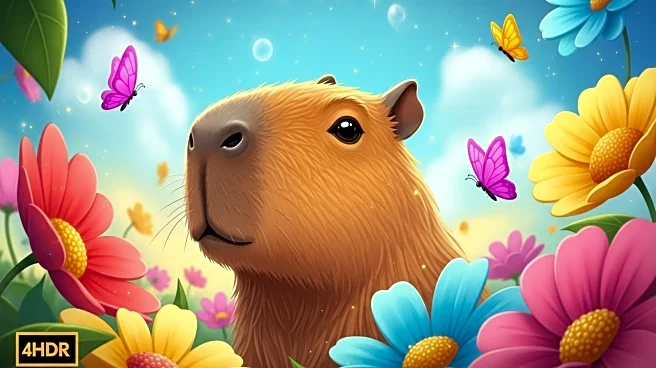What's Happening?
Cinnamon, a capybara who gained international fame after escaping from her enclosure at Hoo Zoo and Dinosaur World in Shropshire, is now the star of a new cartoon. The capybara's escape in September 2024 led to a seven-day search and captured the hearts of many, resulting in internet memes, a song, merchandise, and a book. The cartoon, titled 'Cinnamon's Big Adventure,' is set to premiere on YouTube and will be shown in cinemas nationwide later this year. The story follows Cinnamon's journey through woods and marshes before she is found in a pond, unbothered by her adventure. The zoo owner, Will Dorrell, expressed excitement about the film, noting that it is a special moment to see the story come to life on screen.
Why It's Important?
The story of Cinnamon the capybara highlights the power of viral media in capturing public interest and turning a local incident into a global phenomenon. The cartoon adaptation not only serves as entertainment but also as a marketing tool for Hoo Zoo, potentially increasing visitor numbers and interest in the zoo. The proceeds from the book and related merchandise are being reinvested into the zoo, demonstrating how viral stories can have tangible benefits for local businesses. This case also underscores the growing trend of animal stories gaining popularity and being monetized through various media channels.
What's Next?
The release of 'Cinnamon's Big Adventure' on YouTube and in cinemas is expected to further boost Cinnamon's popularity and the zoo's profile. The zoo plans to use the proceeds from the book and merchandise sales to fund future developments, including a new pond for Cinnamon and her family. As the cartoon reaches a wider audience, it may lead to additional opportunities for merchandise and media adaptations, potentially expanding the zoo's reach and influence.
Beyond the Headlines
Cinnamon's story raises questions about the ethical implications of turning animal escapades into entertainment. While the narrative is light-hearted, it prompts discussions on animal welfare and the responsibilities of zoos in ensuring the safety and well-being of their animals. Additionally, the story reflects broader cultural trends in how society engages with and commercializes viral content, particularly involving animals.











